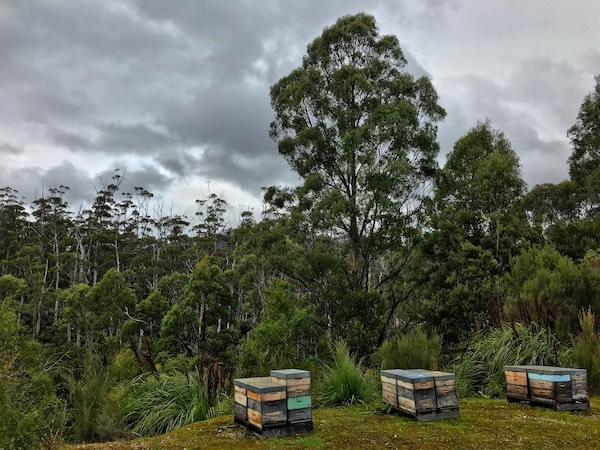More than half of the Australian state of Tasmania is preserved in national and state parks. That doesn’t mean there’s no enterprise. But instead of loggers or miners, the workers are much smaller. Amid the aromatic, shaggy-barked eucalypts towering over more kinds of ferns and shrubby pines than you can imagine in Tasmania’s Southwest National Park, you’ll find hundreds of beehives.
From spring to autumn, trees and shrubs flower in the forest. By the end of the season around March and April, the last trees still blooming are leatherwoods. The bees that visit them produce pure leatherwood honey. It’s a creamy golden color, opaque, thick, pourable yet slightly grainy. The flavor is floral, complex, with a bitter edge that complements the gentle sweetness. And it’s sold in every Australian grocery store I’ve visited, from tiny health food nooks to the big megamarts.
As James McWilliams wrote in his book, Just Food, “An environmentally sound food system is one in which productive endeavors naturally gravitate to geographical locations where the impact on resources is minimized. In other words, producers produce in the right places.”
Tasmania’s rainforests aren’t the only places to produce fantastic tasting food in harmony with nature. Here are a few others from around the globe.
Icelandic geothermal baking
Iceland is a hotbed of geological activity—literally. The landscape is strewn with active volcanoes, tiny earthquakes jostle the ground daily, and it seems nearly every town has its local hot spring. The springs aren’t just good for a nice soak—the geothermal heat rising up from the mud surrounding the springs can also be harnessed for baking bread. They make a dough with plenty of rye flour and sugar, place it in a metal pan and wrap it tightly, then bury it in the boiling mud for 24 hours to create a dark, sweet loaf not unlike Boston brown bread.
Real wild rice
Practically all “wild rice” sold at the grocery is a domesticated variety grown in paddies using conventional agriculture techniques—in other words, it’s no more wild than any other rice out there. True wild rice is an aquatic grass that grows in clear, fresh, slow-moving rivers in the upper Midwest and central Canada. It reseeds itself each autumn when unharvested seeds slip back into the water. The following August, it’s ready to harvest—not by combine, but by hand in canoes.
Sun dried sea salt
To make salt here in Michigan we have to mine it with heavy machinery (that’s how the Kosher brand salt you see at grocery stores is made—it’s mined just north of Ann Arbor). To make it in foggy coastal places like Wales you have to boil it out of the sea water which takes a tremendous amount of fossil fuels. But on sunny coasts, like in Portugal, salt can be harvested from shallow, tidal pools of sea water that evaporate in the sun, gathered with handheld rakes and shovels, not bulldozers.
Grass fed beef
Beef is everyone’s favorite environmentally-unfriendly villain of a food, and generally for good reason: rainforests are cut down to make room for stockyards; the amount of grain it takes to feed one grain-finished steer could practically feed a village; feedlot cattle are kept in such tight quarters that they’re generally fed a boatload of subtherapeutic antibiotics to keep disease from running rampant… the list goes on.
But grass-fed and grass-finished beef is a whole different story—and the science backs it up. Instead of destroying their environment, well-managed grass-fed herds, like Cory Carman’s out on Carman Ranch in Oregon, can play a vital role in building and maintaining grassland soil health, and even have a negative carbon footprint. They also allow humans, who can’t digest grass, to gain nutrition from lands that would otherwise be nonarable.

